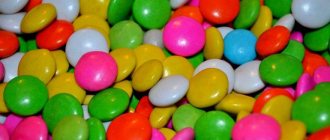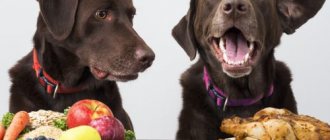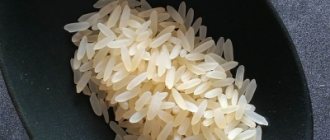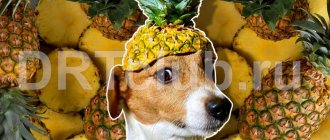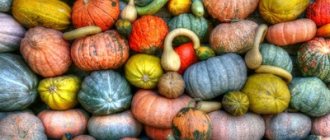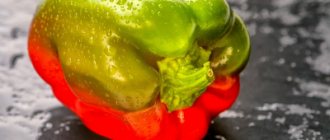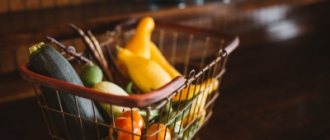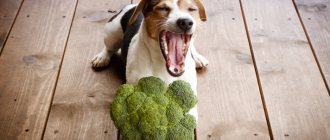Sometimes disputes arise between four-legged owners on the topic: “Which vegetables are healthy for dogs and which are not recommended for consumption at all.” And, I must say, opinions on this matter are quite contradictory. Often, products such as cucumber, broccoli, tomato, bell pepper and many others undeservedly fall into disgrace.
In fact, in the selection of vegetable nutrition components for the canine family, everything is much simpler.
If a particular vegetable (or any product in general) is not suitable for an animal, the pet’s body will quickly react with allergies and problems with the coat.
It is precisely in order to determine whether a particular product is digestible, you need to gradually introduce each of them into the dog’s diet, observing the body’s reaction.
You should not blindly believe everything that is written in numerous publications on the topic: “what is good and what is bad.” Everything is individual. If your pet tolerates one or another “harmful” product well, then there is no need to deprive your pet of the opportunity to receive additional vitamins. But, it goes without saying, moderation is needed in everything.
Any vegetable is good, if your dog does not have allergic reactions to it, it is perfectly absorbed by the body and is well “formed” at the end!
If your dog doesn’t itch, has thick hair and is in a good mood, then you are doing everything right, and the vegetables you feed your dog are suitable for him!
Let's try to figure out in more detail which vegetables are definitely healthy, and which ones can be given to your dog with caution, how often and in what form.
Are vegetables necessary in a dog's diet?
In general, a dog is a predator by nature, so the bulk of the diet, about 70-80%, should be foods containing animal protein: meat, fish, eggs, dairy products. The remaining percentage comes from vegetables and a small amount of cereals.
Probably every dog owner has often observed undigested pieces of vegetables in their pet’s feces. The thing is that dogs do not have enzymes that help break down the shell of plant fiber. For this reason, vegetables and greens are poorly absorbed by the animal’s body.
You ask: “So why then do dogs need vegetables if the animal’s stomach is not able to digest them?”
In fact, it is simply necessary to include this type of food in the diet of tailed animals. Vegetables are a source of indigestible fiber and are needed by the animal’s body as slow carbohydrates, a source of coarse dietary fiber, which creates the right prebiotic environment and helps to better digest meat.
Although fiber is not absorbed by the body, it perfectly regulates intestinal function and removes excess cholesterol from the body. In addition, vegetables are rich in vitamins and microelements, so necessary for every living organism.
How much to give
Cabbage is a healthy crop, but it should not form the basis of the diet and replace other vegetables. If your pet eats greedily and asks for more, it means that the body is experiencing a deficiency of some substances, which is replenished by cabbage. In this case, the portion is not increased, but given daily.
It is difficult to give the serving size of the vegetable in question in grams, since this value depends on the weight and age of the animal. When calculating, it is taken into account that the total amount of vegetables does not exceed 1/5 of the diet, but this cannot be cabbage alone.
In what form should I give vegetables to my dog?
And here the opinions of dog breeders differ. Proponents of the Barf nutrition system, for example, argue that due to the fact that the animal’s body is not able to digest fiber, vegetables should be ground in a blender until pureed.
They refer to the fact that in the wild, the distant ancestors of dogs, wolves, first of all ate the stomach of herbivorous prey in order to obtain a certain amount of plant food, which in turn was already digested in the stomach. In fact, it doesn’t matter at all in what form you give vegetables to your dog.
You can generally alternate serving methods: grind in a blender, grate or cut into cubes or bars. The dog chews vegetables cut into large cubes, thereby also chopping them. Moreover, chewing fresh, raw vegetables further helps prevent plaque formation.
However, this feeding method is not suitable for small puppies and dogs that are being transferred to natural food from dry food. Small puppies simply do not yet know how to chew food well, and an animal switching to natural food is not yet accustomed to certain products and will choose what is tastier for it (and this, of course, will be meat), leaving pieces of vegetables in its bowl.
Not all vegetables are recommended to be cooked. Some of them are best given raw. This way they preserve all valuable vitamins and microelements.
But many vegetables contain beta-carotene, which is better absorbed when stewed with a small addition of animal fat (for example, sour cream or kefir). These vegetables include: carrots, cabbage, tomatoes, eggplants, turnips and beets.
Therefore, it won’t hurt to pamper your pet with a delicious dish of baked vegetables. You can see how I prepare this dish for my Jackusik at the end of the article!
Canned vegetables and herbs are contraindicated for dogs due to the high content of various spices in them.
The benefits of root vegetables
Vegetables are slow carbohydrates and are important for mammals. They are indigestible coarse dietary fiber. These elements are needed to form a prebiotic environment that promotes better digestibility of meat products.
In addition, vegetables contain the following beneficial components:
- vitamins P and C;
- potassium;
- beta-carotene;
- organic acids;
- magnesium;
- folic acid;
- phytoncides;
- minerals.
Vegetables contain many essential nutrients
Acids have a beneficial effect on the digestive process, and phytoncides destroy harmful microorganisms. Vegetables contain protein, which is the building material for the creation of new cells.
Characteristics of vegetables according to the content of useful elements in them:
- The leaves contain folic acid.
- Vegetables that are dark green, orange or red are beta-carotene.
- Dark green leafy ones - calcium.
Root vegetables and edible parts of plants with yellow pigment have antioxidant effects and protect against radiation.
Raw potatoes are considered a useless food for feeding dogs.
Table 1. Content of elements in greens and root vegetables
| Elements | Names of vegetables |
| Protein | Asparagus, peas, corn, broccoli, spinach |
| Cellulose | Brussels sprouts, green beans, sweet corn, pumpkin, carrots, onions, green peas |
| Carbohydrates | Zucchini, peppers, leeks, tomatoes, lettuce, radishes |
What vegetables can you safely give to your pet?
Now let's talk about which vegetables are healthy for dogs and don't cause heated debate.
Pumpkin
Pumpkin improves digestion, reduces the acidity of gastric juice, normalizes stool and treats constipation. Pumpkin is an excellent antioxidant and helps prevent the occurrence of helminths.
Zucchini
Zucchini is a good source of potassium, calcium, beta-carotene and folic acid. As a rule, this vegetable is given raw, but you can pamper your pet with a baked product.
Cucumber
Cucumbers are completely safe for four-legged animals. They are rich in complex organic substances that play an important role in metabolism. The potassium contained in cucumbers improves the functioning of the heart and kidneys.
bell pepper
Bell peppers contain beta-carotene and a number of beneficial B vitamins. Peppers are also rich in potassium and calcium, iron and iodine, magnesium, manganese, phosphorus, fluorine, copper, zinc and sodium.
But in pepper traffic, preference should be given to red pepper, as it contains more microelements and vitamins.
Celery
Earlier, answering the question of what you should not feed your dog, we mentioned that celery is a product rich in potassium, calcium, phosphorus, sodium, amino acids, vitamins A, B and C. The substances contained in this plant have a positive effect on the condition cardiovascular system and prevent the development of cancer.
In addition, celery is an excellent breath freshener and has anti-inflammatory properties, so it can be given to dogs suffering from arthritis. It is recommended to give animals the stem of this plant.
But the consistency of the celery stalk is very hard and fibrous. And since when eating food, the dog does not chew it, but swallows it in pieces, it will be difficult for unchewed pieces of the plant to pass through the animal’s esophagus. Therefore, if you want to introduce this plant into your dog’s diet, then either cut it into small pieces or grind the plant stems in a blender.
Carrot
Carrots are rich in vitamin A and beta-carotene, which help improve vision, reduce the risk of tumors and add shine to the coat.
In addition, raw carrots are good for cleaning plaque on teeth, reducing the number of pathogenic bacteria in the mouth, reducing unpleasant odor and training the jaw muscles.
But be careful, carrots can cause allergies in some dogs.
Cauliflower
Many pet owners are afraid to give this vegetable to dogs, and completely in vain. Cauliflower is absorbed by the body better than all other types of cabbage. It contains less coarse fiber than, for example, cabbage, so it is easily digested and does not irritate the gastric mucosa. It is especially useful for gastrointestinal diseases. For liver and gallbladder disease, only those vegetables that increase the secretion of bile and promote regular bowel movements are recommended. These include cauliflower.
Turnip
Turnips are a rich source of calcium. It has a diuretic, antiseptic and anti-inflammatory effect, improves food absorption. Turnips are good both raw and baked. However, some animals are weakened by this vegetable.
Turnips are not recommended for use in acute diseases of the gastrointestinal tract and chronic diseases of the liver and kidneys.
Radish
Radish contains a lot of coarse fibers and is a kind of toothbrush for the animal. However, it is not recommended for pets with gastrointestinal problems.
Green bean pods
Green bean pods are very good either fresh or boiled. They are an excellent addition to tripe dishes.
In the winter, I often buy frozen bags of green beans and add this vegetable to Jack's meals.
Caution: urolithiasis
Owners of dogs with oxalate and urate type urolithiasis should be more careful than others when it comes to choosing vegetables. Dogs with urolithiasis should not be given vegetables high in oxalates and oxalic acid, since these substances are excreted in the urine and can form stones.
Stop list for oxalate urolithiasis: beets, carrots, green beans and other legumes, zucchini, broccoli
Possible: pumpkin
Vegetables that are controversial about their benefits or harm
There are vegetables that are not strictly prohibited. However, some of them are not beneficial enough, while others are not suitable for all dogs and can cause serious harm to the pet's health if due care is not taken.
Beet
This root vegetable is rich in potassium, antioxidants and folic acid. But this is a rather allergic vegetable.
If your dog is not allergic to beets, then a small amount will only be beneficial. Eating this vegetable will give a rich and bright color to dogs with red hair. In large quantities it can cause diarrhea.
Tomatoes
Tomatoes are generally included in the list of foods not recommended for dogs because, when fed in large quantities, they can cause stomach upset, cardiac dysfunction, rapid heartbeat, muscle weakness and tremors.
However, in small quantities, it is quite a healthy vegetable. Tomatoes serve as an excellent prevention of plaque formation. They are a strong antioxidant and a good remedy for fighting inflammatory processes.
Therefore, if the dog is not allergic to tomatoes, then it is recommended to include them in the four-legged diet in reasonable quantities. Fresh ripe tomatoes are the safest.
Broccoli
Some dog breeders have undeservedly included this vegetable in the list of not recommended. This was done because this variety of cabbage contains a substance called isocyanate, which is a toxin for dogs and can cause the death of the animal.
However, in order for this vegetable to do any harm, you need to give it to your pet daily in large quantities and as only the only vegetable.
Broccoli is rich in microelements and vitamins C and K. And in terms of vitamin A content, it surpasses all other cabbage plants. All valuable vitamins are preserved much longer in frozen cabbage. Therefore, I safely buy frozen broccoli and, from time to time, add it to my Jack’s food along with other vegetables.
Cabbage
White cabbage is an excellent source of sulfur, calcium, potassium, phosphorus, beta-carotene and vitamins A, B and C. And, I must say, many pets love it very much because they can crunch and chew hard pieces of leaves.
But fresh cabbage is not recommended for dogs in large quantities, as it causes gas formation, stomach turmoil and intestinal pain. But with boiled or stewed cabbage, you can pamper your pet from time to time.
Eggplant
This vegetable is rich in fiber, phosphorus, iron and carotene. However, it is not recommended to be given to animals with kidney disease. Eggplant can cause allergies in some dogs. Recommended for feeding baked or slightly stewed, but not on an ongoing basis.
Frequency of zucchini consumption
If you want to add zucchini to your dog's diet more often, it may be easier to look into a diet that already contains zucchini as part of balanced ingredients. Some dog food brands already do this. As always, we recommend that you take a closer look at the company and evaluate its reliability before purchasing any new products.
Remember, you should always change your dog's diet slowly, carefully increasing the amount of the new diet and decreasing the amount of the old diet over a period of at least one to two weeks for dogs prone to stomach upsets.
You should also remember that each food has a different calorie content, so if you do change food, you should read the feeding instructions for the new food to check how much your dog needs.
Vegetables not recommended for feeding
There is a certain list of vegetables that are not recommended for feeding to a dog.
Corn
In general, corn is not a dangerous vegetable for dogs. But you can’t call it useful either. Corn is often added to cheap pet foods because it is inexpensive, high in fiber, and very filling. This is, perhaps, all her dignity.
Although corn is a source of protein, dogs do not have the enzymes to digest it. Therefore, at the exit you can see whole, undigested grains.
However, despite the dubious benefits of this vegetable, corn is perhaps the most important component of dry dog food.
Potato
In its raw form, this vegetable is a source of solanine, a very dangerous and toxic substance.
As for boiled potatoes, they are a rich source of carbohydrates and starch, which contribute to obesity and joint problems, arthritis.
All the more strange is the fact that despite the absolute uselessness of this product, very often in the composition of expensive animal feed you can see starch as the main filler.
Onion and garlic
It is believed that dogs should absolutely not be given onions and garlic. This is due to the fact that onions and garlic contain thiosulfates, which negatively affect red blood cells and can cause anemia (anemia).
But in order for serious problems to arise, you need to regularly feed your pet 5-6 heads of garlic per week! You understand that this is simply physically impossible!
If your dog accidentally eats a small piece of onion, nothing bad will happen. Sometimes I give one clove of garlic to Jack along with a dried piece of bread as a prophylactic against helminths.
Legumes
Peas, beans, lentils, beans do not provide any benefit and are poorly digested by the animal’s body, causing flatulence.
Mushrooms
Everyone knows that mushrooms, like a sponge, absorb harmful substances from the environment. They attract heavy metal salts and radioactive particles like a magnet and are poorly absorbed due to the high content of chitin in them.
If the human body can digest such heavy food, then eating mushrooms by a dog can lead to disruption of the pancreas and liver. Therefore, it is better not to take risks and completely exclude this product from the animal’s diet.
Zucchini: raw and cooked
Dogs can eat raw or cooked, but cooked zucchini is easier to chew.
Just like people, dogs can eat zucchini raw or cooked—it doesn't matter. Dogs may prefer cold-cooked zucchini because it contains more sugar and tastes sweeter.
If you do cook zucchini for your dog, baking without oil is often the best cooking method. Be careful not to cook it with other foods that people eat. Both garlic and oil are commonly cooked with zucchini, and both can cause problems for your dogs.
Do dogs need greens?
Just like with vegetables, a dog's digestive system is not designed to digest greens. And the pets themselves do not have any particular passion for young shoots of edible herbs, especially aromatic ones. But it is still necessary to include them in the diet in small quantities due to the huge content of valuable vitamins and minerals in greens.
The following types of greens are useful: lettuce, dill, parsley, fresh nettle and dandelion leaves, burdock leaves and stems, seaweed (a source of iodine and microelements that have a beneficial effect on wool and skin), spinach.
From time to time you can include basil, mint, and lemon balm in your diet.
Puppies, pregnant or lactating
Feeding a mother before and after childbirth depends entirely on her appetite, her condition and food preferences. Usually it is milk porridge and meat puree with vegetables.
Boiled or stewed cabbage with meat is an important component in the presence of calcium, vitamin C and other necessary elements. You can forget about the vegetable in its raw form, because babies get absolutely everything that their mother eats, and excess gas formation is extremely undesirable for her, either “before” or “after”.
Attention! It is important to accustom animals to natural feeding in a timely manner. After getting acquainted with milk, cereals and meat supplements, vegetable soup appears on the children's menu, to which a pinch of finely chopped raw cabbage is added with boiled cereals and finely chopped steamed meat.
Puppy meal options:
- vegetable soups;
- porridge in vegetable broth with meat and cabbage;
- separately cooked meat with vegetables.
Chop or finely grate all plant foods, add a little butter or sour cream.
An irreplaceable vitamin supplement in the form of a mixture is also served as an independent dish. When the puppies grow up and get stronger, the diet includes a salad of fresh vegetables with vegetable oil.

